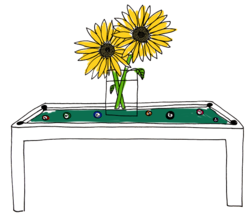Diverging paths
 The error in the
previous problem
doesn't grow with time. This is a hallmark of a nonchaotic system. We can characterize this more formally by saying that
nearby paths don't diverge
. All the ball trajectories that started out near the origin stayed together over time.
The error in the
previous problem
doesn't grow with time. This is a hallmark of a nonchaotic system. We can characterize this more formally by saying that
nearby paths don't diverge
. All the ball trajectories that started out near the origin stayed together over time.
In a chaotic system, on the other hand, nearby paths diverge, even if they are infinitesimally nearby. In such a system the time evolution becomes unpredictable, as you would need to know the initial conditions of the system to infinite accuracy. This is chaos!
It is possible to turn a billiard table into a chaotic billiard table, or one where the trajectory of the ball becomes unpredictable over long times if there is any error. To do this we can put a shape in the middle of the table off which the ball will bounce.
Suppose we start the ball at the bottom of the table at (0,-2) with an error in the -component of its position. The initial velocity is (0,1). Which shape in the middle will cause the motion of the ball to become chaotic?
This section requires Javascript.
You are seeing this because something didn't load right. We suggest you, (a) try
refreshing the page, (b) enabling javascript if it is disabled on your browser and,
finally, (c)
loading the
non-javascript version of this page
. We're sorry about the hassle.
Since the structures like hexagon, triangle, etc. are polygons with straight line segment sides, so when the ball is rolled off with these structures in middle, the sides of the polyon become a horizontal base for the bouncing off and thus the system remains non-chaotic.
But, when a circle is placed, every point of the circle is facing different directions and it diverges the movement of the ball which you can clearly visualize.
So, A circle in the middle of the table will make the motion of the ball chaotic.